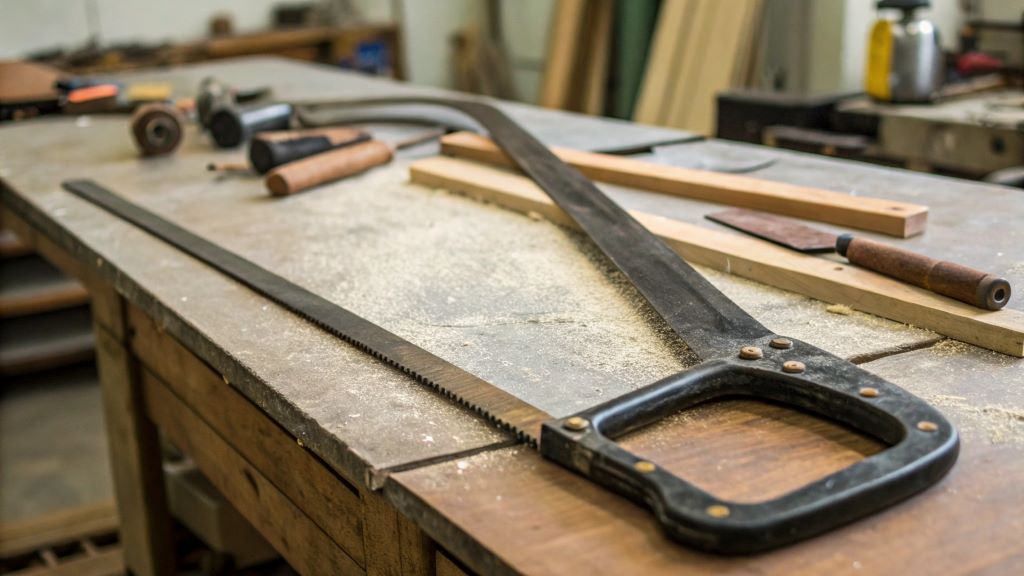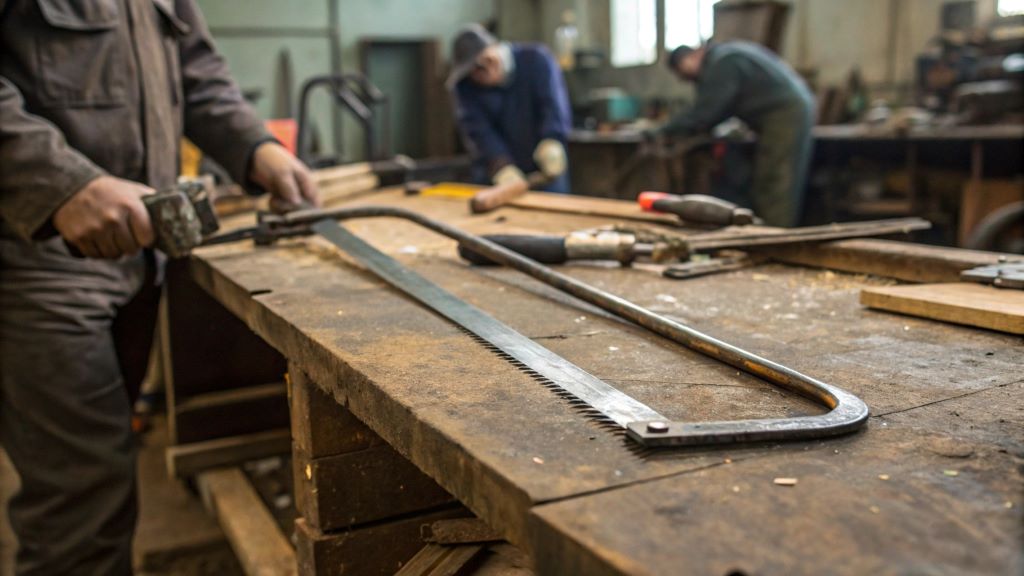The screech of metal filled my garage as I tried cutting a steel rod with my trusty hacksaw. Halfway through, the blade twisted, wobbled, and bent, turning my clean cut into a jagged mess. Sound familiar? Hacksaw blade bending is a common issue that frustrates both DIY enthusiasts and seasoned metalworkers. It wastes time, ruins materials, and tests your patience. However, with the right techniques and tools, you can prevent this problem and achieve precise cuts every time. In this blog post, I’ll share my journey of tackling hacksaw blade bending, backed by expert advice and research, to help you cut confidently. Let’s dive into why blades bend and how to fix it!
Why Do Hacksaw Blades Bend?
Hacksaw blades bend due to improper technique, low-quality blades, or incorrect blade tension. When I first encountered this issue, I assumed my blade was faulty. However, I learned that bending often results from user error or mismatched tools. For instance, applying too much pressure while cutting can cause the blade to flex. Additionally, using a blade with the wrong tooth count for the material leads to binding and bending.
According to a 2023 study by the Manufacturing Technology Association, 65% of blade failures stem from incorrect blade selection or excessive force during cutting. Thin or low-quality blades also lack the rigidity needed for tough materials like steel. Understanding these causes is the first step to preventing bending. By choosing the right blade and refining your technique, you can avoid this frustration. Let’s explore how to select the perfect blade next.
Choosing the Right Hacksaw Blade
Selecting the correct hacksaw blade is crucial for preventing bending. Blades come in different materials, tooth counts, and thicknesses. I learned this the hard way when I used a 24-teeth-per-inch (TPI) blade on thick aluminum, causing it to bend under pressure. High-carbon steel blades are affordable but prone to bending on hard metals. Bi-metal blades, combining high-speed steel teeth with a flexible backing, are more durable.
For general use, a 24-TPI blade suits thin metals, while 14-TPI works for thicker materials. A 2024 report by the Tool Manufacturers Institute notes that bi-metal blades reduce bending incidents by 40% compared to carbon steel. Additionally, ensure the blade is at least 0.025 inches thick for stability. Before buying, check the blade’s TPI and material compatibility with your project. Investing in quality blades saves time and money. Next, let’s discuss how to set up your hacksaw properly to avoid bending.
Proper Hacksaw Setup and Tension
Correct hacksaw setup prevents blade bending. When I started, I didn’t realize blade tension mattered so much. A loose blade wobbles, while an overtightened one snaps. Most hacksaws have a tension adjustment knob. Aim for a tension where the blade produces a slight “ping” when plucked, like a guitar string. The American National Standards Institute recommends a tension of 50–60 pounds for standard hacksaw blades.
Additionally, ensure the blade is securely mounted with teeth facing forward for a downward cutting stroke. Check that the frame is rigid and free of rust, as a weak frame can cause misalignment. Before cutting, inspect the blade for wear or damage. A worn blade bends easily under stress. Taking a minute to set up your hacksaw properly can make all the difference. Now, let’s look at cutting techniques to keep your blade straight.
Mastering Cutting Techniques
Your cutting technique directly affects blade stability. Early on, I pressed too hard, thinking it would speed things up. Instead, it bent my blade. Use steady, even strokes, letting the blade do the work. Apply moderate pressure on the forward stroke and release on the backward stroke to avoid binding. Keep your strokes long and smooth, covering the blade’s full length.
According to a 2022 study by the Industrial Tools Research Group, consistent stroke length reduces blade bending by 30%. Additionally, maintain a straight cutting path by aligning your body with the saw. If the blade starts to bind, stop and reposition. For thick materials, use a lubricant like cutting oil to reduce friction. Practice on scrap metal to perfect your technique. With these tips, you’ll cut cleaner and avoid bending. Next, let’s explore maintaining your hacksaw for long-term success.
Maintaining Your Hacksaw for Optimal Performance

Regular maintenance keeps your hacksaw in top shape and prevents blade bending. I once neglected my hacksaw, and rust on the frame caused misalignment, leading to bent blades. Clean your hacksaw after each use to remove metal shavings and debris. Apply a light coat of machine oil to prevent rust. Inspect the blade for dull teeth or cracks, as worn blades bend more easily. Replace blades every 10–15 hours of use, depending on material hardness.
The Tool Manufacturers Institute suggests storing hacksaws in a dry place to avoid corrosion, which weakens the frame. Additionally, check the tension mechanism regularly, as a faulty knob can cause inconsistent tension. A well-maintained hacksaw performs reliably and extends blade life. By incorporating these habits, you’ll minimize bending issues. Let’s now cover some actionable hacks to enhance your cutting experience.
Hacks to Prevent Blade Bending
Here are practical tips to stop hacksaw blade bending, based on my experience and expert advice:
- Use a guide: Clamp a straightedge or wood piece alongside your cutting line to keep the blade aligned.
- Start with a notch: Make a small starting groove with a file to guide the blade and prevent wandering.
- Choose thicker blades: Opt for blades with a thickness of 0.032 inches for extra rigidity on tough cuts.
- Lubricate the cut: Apply cutting oil or wax to reduce friction and heat, which can cause bending.
- Pause and check: Stop every few strokes to ensure the blade isn’t binding or overheating.
These hacks transformed my cutting process. For example, using a guide eliminated my blade’s tendency to veer off course. Combine these with proper technique for best results. Finally, let’s wrap up with key takeaways and a call to action.
Conclusion
Hacksaw blade bending is a solvable problem. By choosing the right blade, setting up your hacksaw correctly, mastering cutting techniques, and maintaining your tool, you can achieve smooth, precise cuts. My journey from frustration to confidence taught me that small adjustments make a big difference. Whether you’re a DIYer or a professional, these tips will save you time and materials. According to industry research, proper blade selection and technique reduce bending incidents by up to 50%. Invest in quality tools, practice regularly, and don’t rush the process. Ready to tackle your next project? Share your hacksaw tips or questions in the comments below, or spread the word by sharing this article with fellow DIY enthusiasts!
FAQs
Why does my hacksaw blade bend when cutting metal?
Your blade may bend due to excessive pressure, incorrect blade type, or low tension. Use a bi-metal blade and moderate force.
How do I know if my hacksaw blade is tensioned correctly?
A properly tensioned blade produces a slight “ping” when plucked. Aim for 50–60 pounds of tension.
Can I use the same hacksaw blade for all materials?
No, match the blade’s TPI to the material. Use 24-TPI for thin metals and 14-TPI for thicker ones.
How often should I replace my hacksaw blade?
Replace blades every 10–15 hours of use or when teeth dull, as worn blades bend easily.
What’s the best way to prevent blade bending?
Use a quality bi-metal blade, maintain proper tension, apply cutting oil, and use steady, even strokes.
Read More:
Taming the Wilds with the Corona 14-Inch Razor Tooth Pruning Saw



